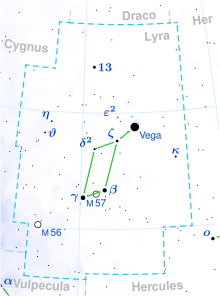
A | B | C | D | E | F | G | H | CH | I | J | K | L | M | N | O | P | Q | R | S | T | U | V | W | X | Y | Z | 0 | 1 | 2 | 3 | 4 | 5 | 6 | 7 | 8 | 9
| Observation data Epoch J2000.0 Equinox J2000.0 | |
|---|---|
| Constellation | Lyra |
| Right ascension | 18h 19m 51.70908s[1] |
| Declination | +36° 03′ 52.3691″[1] |
| Apparent magnitude (V) | 4.33[2] |
| Characteristics | |
| Evolutionary stage | giant |
| Spectral type | K2-IIIabCN0.5[3] |
| U−B color index | +1.17[4] |
| B−V color index | +1.162±0.013[2] |
| Variable type | suspected[5] |
| Astrometry | |
| Radial velocity (Rv) | −24.36±0.13[6] km/s |
| Proper motion (μ) | RA: −16.75[1] mas/yr Dec.: +41.09[1] mas/yr |
| Parallax (π) | 12.96 ± 0.14 mas[1] |
| Distance | 252 ± 3 ly (77.2 ± 0.8 pc) |
| Absolute magnitude (MV) | −0.11[2] |
| Details | |
| Radius | 18[6] R☉ |
| Luminosity | 127.4[7] L☉ |
| Surface gravity (log g) | 2.51[8] cgs |
| Temperature | 4,638[8] K |
| Metallicity | +0.13[8] dex |
| Rotational velocity (v sin i) | 5.0[6] km/s |
| Other designations | |
| Database references | |
| SIMBAD | data |
κ Lyrae, Latinized as Kappa Lyrae, is a solitary[10] star in the northern constellation of Lyra, near the constellation border with Hercules. It is visible to the naked eye as a faint, orange-hued point of light with an apparent visual magnitude of 4.33.[2] This object is located approximately 252 light years from the Sun based on parallax,[1] but is moving closer with a radial velocity of −24 km/s.[6]
This is an aging giant star with a stellar classification of K2-IIIabCN0.5,[3] with the suffix notation indicating a mild underabundance of cyanogen. Having exhausted the supply of hydrogen at its core, the star has cooled and expanded. It now has 18[6] times the Sun's girth and is radiating 127[7] times the luminosity of the Sun at an effective temperature of 4,638 K.[8] κ Lyrae is a red clump giant, which means it is on the horizontal branch and is generating energy through core helium fusion.[11] It is a suspected small amplitude variable star.[5]
References
- ^ a b c d e f van Leeuwen, F. (2007), "Validation of the new Hipparcos reduction", Astronomy and Astrophysics, 474 (2): 653–664, arXiv:0708.1752, Bibcode:2007A&A...474..653V, doi:10.1051/0004-6361:20078357, S2CID 18759600.
- ^ a b c d Anderson, E.; Francis, Ch. (2012), "XHIP: An extended hipparcos compilation", Astronomy Letters, 38 (5): 331, arXiv:1108.4971, Bibcode:2012AstL...38..331A, doi:10.1134/S1063773712050015, S2CID 119257644.
- ^ a b Keenan, Philip C.; McNeil, Raymond C. (1989), "The Perkins catalog of revised MK types for the cooler stars", Astrophysical Journal Supplement Series, 71: 245, Bibcode:1989ApJS...71..245K, doi:10.1086/191373.
- ^ Mermilliod, J.-C. (1986), "Compilation of Eggen's UBV data, transformed to UBV (unpublished)", Catalogue of Eggen's UBV Data. SIMBAD, Bibcode:1986EgUBV........0M.
- ^ a b Percy, J. R.; et al. (1994), "Photometric surveys of suspected small-amplitude red variables. III: An AAVSO photometric photometry survey", Astronomical Society of the Pacific, 106 (700): 611–615, Bibcode:1994PASP..106..611P, doi:10.1086/133420.
- ^ a b c d e Massarotti, Alessandro; et al. (January 2008), "Rotational and radial velocities for a sample of 761 HIPPARCOS giants and the role of binarity", The Astronomical Journal, 135 (1): 209–231, Bibcode:2008AJ....135..209M, doi:10.1088/0004-6256/135/1/209, S2CID 121883397.
- ^ a b McDonald, I.; et al. (2012), "Fundamental Parameters and Infrared Excesses of Hipparcos Stars", Monthly Notices of the Royal Astronomical Society, 427 (1): 343–57, arXiv:1208.2037, Bibcode:2012MNRAS.427..343M, doi:10.1111/j.1365-2966.2012.21873.x, S2CID 118665352.
- ^ a b c d Maldonado, J.; et al. (June 2013), "The metallicity signature of evolved stars with planets", Astronomy & Astrophysics, 554: 18, arXiv:1303.3418, Bibcode:2013A&A...554A..84M, doi:10.1051/0004-6361/201321082, S2CID 119289111, A84.
- ^ "kap Lyr". SIMBAD. Centre de données astronomiques de Strasbourg. Retrieved October 14, 2007.
- ^ Eggleton, P. P.; Tokovinin, A. A. (2008), "A catalogue of multiplicity among bright stellar systems", Monthly Notices of the Royal Astronomical Society, 389 (2): 869, arXiv:0806.2878, Bibcode:2008MNRAS.389..869E, doi:10.1111/j.1365-2966.2008.13596.x, S2CID 14878976.
- ^ Alves, David R. (August 2000), "K-Band Calibration of the Red Clump Luminosity", The Astrophysical Journal, 539 (2): 732–741, arXiv:astro-ph/0003329, Bibcode:2000ApJ...539..732A, doi:10.1086/309278, S2CID 16673121.
Text je dostupný za podmienok Creative Commons Attribution/Share-Alike License 3.0 Unported; prípadne za ďalších podmienok. Podrobnejšie informácie nájdete na stránke Podmienky použitia.
Antropológia
Aplikované vedy
Bibliometria
Dejiny vedy
Encyklopédie
Filozofia vedy
Forenzné vedy
Humanitné vedy
Knižničná veda
Kryogenika
Kryptológia
Kulturológia
Literárna veda
Medzidisciplinárne oblasti
Metódy kvantitatívnej analýzy
Metavedy
Metodika
Text je dostupný za podmienok Creative
Commons Attribution/Share-Alike License 3.0 Unported; prípadne za ďalších
podmienok.
Podrobnejšie informácie nájdete na stránke Podmienky
použitia.
www.astronomia.sk | www.biologia.sk | www.botanika.sk | www.dejiny.sk | www.economy.sk | www.elektrotechnika.sk | www.estetika.sk | www.farmakologia.sk | www.filozofia.sk | Fyzika | www.futurologia.sk | www.genetika.sk | www.chemia.sk | www.lingvistika.sk | www.politologia.sk | www.psychologia.sk | www.sexuologia.sk | www.sociologia.sk | www.veda.sk I www.zoologia.sk

